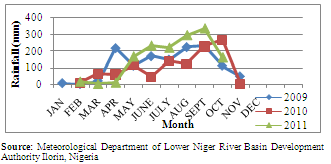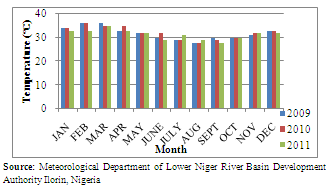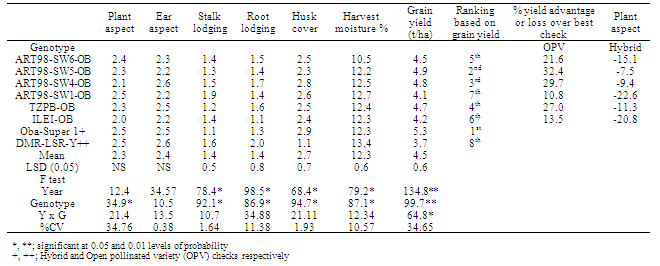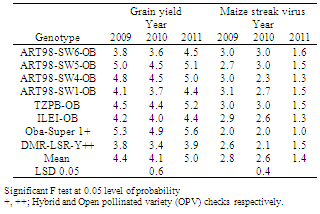-
Paper Information
- Next Paper
- Previous Paper
- Paper Submission
-
Journal Information
- About This Journal
- Editorial Board
- Current Issue
- Archive
- Author Guidelines
- Contact Us
International Journal of Agriculture and Forestry
p-ISSN: 2165-882X e-ISSN: 2165-8846
2012; 2(5): 203-209
doi: 10.5923/j.ijaf.20120205.03
Yield and Disease Reactions of Quality Protein Maize Varieties in the Southern Guinea Savanna Agro-Ecology of Nigeria
Bello O. B 1, Ganiyu O. T 1, Wahab M. K. A 1, Azeez M. A 2, Abdulmaliq S. Y 3, Ige S. A 4, Mahmood J 5, Oluleye F 6, Afolabi M. S 7
1Department of Biological Sciences, Fountain University, Osogbo, Osun State, Nigeria
2Department of Plant Biology, Ladoke Akintola University of Technology, Ogbomoso, Nigeria
3Department of Agronomy, Ibrahim Badamasi Babangida University, Lapai, Niger State, Nigeria
4Department of Agronomy, University of Ilorin, Ilorin, Nigeria
5Lower Niger River Basin Development Authority, Ilorin, Kwara State, Nigeria
6Kwara State University, Malete, Ilorin, Kwara State, Nigeria
7Department of Crop Science, Landmark University, Omuaran, Kwara State, Nigeria
Correspondence to: Bello O. B , Department of Biological Sciences, Fountain University, Osogbo, Osun State, Nigeria.
| Email: |  |
Copyright © 2012 Scientific & Academic Publishing. All Rights Reserved.
Experiments were conducted on six newly developed quality protein maize (QPM) lines and two check entries for three years (2009-2011). The objective was to assess their yield potentials and disease tolerance/ resistance in the southern Guinea savanna agro-ecology of Nigeria. Genotype and year of evaluation were significant for (P<0.01 and <0.05) for grain yield, harvest moisture and lodging characteristics. Variety x year interactive effect for grain yield revealed different genotypic performance of the varieties tested with two checks (Oba-Super 1 and DMR-LSR-Y) being responsible for the significant differences obtained in the three years of evaluation. Average grain yield was significantly higher in the year 2011 compared to 2009 and 2010. All the genotypes tested were moderately tolerant to the five diseases. Four QPM lines (ART98-SW5-OB, ART98-SW4-OB, TZPB-OB and ART98-SW6-OB) were superior for grain yield with yield advantage of 28% over the best OPV check. They were also compared favourably with the hybrid check for grain yield. These QPM varieties can therefore serve as useful replacement to existing cultivars and also as source of genes for future maize breeding activities in the development of superior maize varieties with high protein contents for the savanna agro-ecology. This could also be a panacea to solving food insecurity in Nigeria.
Keywords: Quality protein, maize yield, disease tolerance/ resistance
Article Outline
1. Introduction
- Maize (Zea mays L.) has a critical nutritional role to play in human as it is one of the most important cereals in the world after wheat and rice with regards to cultivation area, total production and consumption[1]. Maize is high yielding, easy to process, readily digested and cheaper than other cereals. It is also a versatile crop, growing across a wide range of agro ecological zones[2]. In Nigeria, conventional maize is used directly for human consumption as well as infant nutrition in the form of porridge during weaning period without any protein supplement such as egg, meat or beans, which are comparatively expensive especially for poor-resource in the rural areas[3]. Normal maize has 10% protein which is of poor nutritional quality due to limiting concentration of essential amino acids (lysine and tryptophan) which the human body cannot synthesize and has to be supplemented[4-6]. Therefore adoption and cultivation of QPM with high concentration of lysine and tryptophan contents therefore could drastically reduced malnutrition, diseases and death among low income maize consumers in the developing countries including Nigeria[6-9].Generally, maize production in tropical Africa is constrained by a number of stress factors including a complex of pests and diseases that significantly reduce the quantity and quality of production[10]. Grain yield losses ranging from 0-70% have been reported due to some of the major diseases which depend on factors such as genetic constitution of the cultivars and stage of growth at the time of infections[11]. Meanwhile, maize diseases of tropical environment such as maize streak virus (MSV) are transmitted by Cicardulina spp and southern leaf blight is caused by the fungus Helminthosporium maydis. The causative organism of the curvularia leaf spot is Curvularia lunata, and that of maize ear rot is Fusarium moniliforme. Maize rust on the other hand is incited by Puccinia polysora[10,12]. These five diseases constitute major production constraints in the northern and southern Guinea savanna of Nigeria. They often occur together on maize plants as mixed infections and their occurrence is favoured by warm and humid climate[13,14]. However, ear and kernel rot diseases decreased grain yield quality and feeding value of the grain, and in some instances, this has even resulted in the production of toxic substances in feed rations. Foliar diseases also reduced the production of carbohydrates stored in the grains, resulting in immature and chaffy kernels, hence low and poor yields[8,15]. The quest for improved grain yield and disease tolerance/ resistance maize varieties therefore become imperative for profitable maize production. The use of host plant resistance/ tolerance however remains the most economically viable and practical means of controlling disease epidemics[11].Quality protein maize varieties are known to be more vulnerable to diseases because of the soft floury endosperm of the Opaque-2 maize which foster fungal growth[16]. Meanwhile, newly developed QPM varieties are routinely evaluated in various agro-ecological zones of Nigeria for adaptation, yield potentials and disease reactions, to identify genotypes that can replace existing cultivars and as part of the requirements for releasing suitable varieties for cultivation in the farmers’ fields[8,17]. Therefore, assessment of newly developed QPM varieties reaction to diseases that may be unique to the environment before being recommended for cultivation is very imperative[18]. In the study reported herein, six (6) newly developed QPM varieties were evaluated along with an earlier version (DMR-LSR-Y) and one hybrid (Oba Super 2) as checks for three years at Ilorin, a typical southern Guinea savanna ecology of Nigeria. The objective was to assess yield performance and reactions of the QPM varieties to five major field diseases: curvularia leaf spot, southern leaf blight, maize rust, ear rot and streak virus prevalent in the agro-ecology with the view to identify high yielding and disease resistant/ tolerant QPM cultivars either suitable for direct cultivation in this ecology or for further improvement in the breeding programmes.
2. Materials and Methods
2.1. Germplasm used
- Six newly developed QPM and two local (checks) varieties were evaluated for yield performance and disease reactions in the southern Guinea savanna agro-ecology of Nigeria. The field trials were conducted at the Lower Niger River Basin Development Authority station, Oke-Oyi, Ilorin, Nigeria (Latitude 8°30’N & 8°36’E and Longitude 4°31’N, & 4°33’E) during late cropping seasons of 2009, 2010 and 2011. Table 1 shows the source of collection and characteristics of the QPM varieties and checks, while monthly rainfall, temperature and relative humidity data collected from Meteorological Department of Lower Niger River Basin Development Authority Ilorin are presented in Figure 1, 2, and 3 respectively.
 | Figure 1. Monthly rainfall distribution pattern (3 years) at Ilorin from 2009 to 2011 |
 | Figure 2. Monthly relative humidity (3 years) at Ilorin from 2009 to 2011 |
 | Figure 3. Monthly atmospheric temperature (3 years) at Ilorin from 2009 to 2011 |
2.2. Experimental Design and Cultural Practices
- Maize seeds were planted under rainfed on 26th July, 2009, 28th July, 2010 and 2nd August, 2011 in a randomized complete block design with four replications. Each plot consisted of four rows of 5m long, with 0.50m intra-row and 0.75m between rows spacing respectively. Three seeds were planted per hill, drilled 3-4cm deep in the ridges and thinned to two plants per hill two weeks after seedling emergence to provide a uniform plant population of about 53,333 plants /ha. NPK fertilizer was applied at the rate of 80 kg N, 40 kg P2O5 and 40 kg K2O per hectare for optimum plant growth. All plots were weeded by using herbicides (a.i. 3kg/l Metolachlor, 170g/l Atrazine and 3kg/l Paraquat per hectare) and supplemented by hand weeding to achieve weed control. This was supplemented by a regime of hand weeding 6 weeks after planting to achieve weed control, improve soil aeration and prevent root lodging.
2.3. Field Measurements
- Just before flowering, all plants from the two middle rows in a plot were observed and counted for five foliar diseases symptoms (curvularia leaf spot, southern leaf blight, maize rust, ear rust and streak virus) prevalent in the area. Severity of each of the five diseases were evaluated using rating scale of 1-5 where, 1 = no symptom, 2 = slight infection, 3 = moderate infection, 4 = high infection, 5 = very high infection. When the cobs were fully developed, the genotypes were assessed for their susceptibility to root and stem lodging based on scale of 1-5, where, 1= excellent (no lodging) 2 = very good, 3 = good, 4 = fair and 5 = poor. At harvest, husk cover as well as plant and ear aspects were rated visually on a scale of 1 to 5 where 1 = clean, uniform, well covered husk, deep greenish plant appearance, large and well-filled ears respectively, and 5 = opened husk, yellowish plant appearance as well as rotten, small and partially filled ears respectively. Grain yield was obtained from ear weight per plot (assuming 80% shelling percentage) and converted to tonnes per hectare after adjusting to 12.5% moisture content. Three hundred grain samples were collected from each plot at harvest for the determination of harvest moisture. In the laboratory, the samples were first weighed to obtain initial weight, followed by drying to a constant weight in the oven at 80℃, and the difference between the two weights recorded as moisture at harvest.
2.4. Statistical Analyses
- Data collected were subjected to analyses of variance (ANOVA) first on individual year basis before a combined ANOVA over years using PROC GLM model of SAS[19] to compute mean squares for each character. The degree of variation was determined using % coefficient of variation P< 0.05. Differences in character means were also measured using least significant difference (LSD).
3. Results
3.1. Rainfall, Temperature and Relative Humidity of the Site
- Rainfall amount and distribution during the three-year cropping period (Figure 1) was evenly distributed throughout the flowering/grain filling periods of September to October. In the month of August however, there was a sharp drop in rainfall in the year 2009 and early onset of terminal drought in 2010. Relative humidity in the three years (Figure 2) was very high in 2009 with the peak in August of that year, whereas decline in relative humidity in August was recorded in 2010 and 2011 in that order. Atmospheric temperature across the years on the other hand, was very high in February, 2009 and 2010 as well as March, 2009 compared to 2011. This is followed by gradual decrease until minimum temperature is reached in August. Thereafter, there was a steady rise in temperature to December in the three years (Figure 3).The three years differed significantly only (P <0.05) for grain yield, lodging characteristics, harvest moisture and husk cover (Table 2). Grain yield was significantly higher in 2011 by 0.9 t/ha compared to 2010 that had the lowest yield, representing 22% yield increase. This increase was accompanied by higher grain moisture content, lower disease rating for lodging characteristics as well as plant and ear aspects. Husk cover had lower score in both 2009 and 2010 compared to 2011. However, rating for ear aspect (although non-significant) was better in 2009 and 2010 when the volume of rainfall was low in October, which also coincided with period of crop maturity compared to similar period in 2011. Similarly, plant aspect remained relatively unaffected by differences in growing conditions among the three years, while year 2011 had highest score rating.
|
|
|
|
|
4. Discussion
- The main effort in varietal evaluation of QPM varieties in the developing countries is to identify superior genotypes that could replace existing cultivars. The QPM varieties can serve as sources of genes for the extraction of inbred lines aimed at development of productive cultivars that will increase protein intake in the rural poor setting. Generally, rainfall amount and distribution as well as relative humidity and atmospheric temperature during the growing periods in the three years played significant role in the expression of genotypes’ potential in this study. The reflection of weather pattern (available soil moisture, temperature, relative humidity, etc.) during crop’s reproductive phase may stimulate plants to speed up the process of maturation with vulnerable disease infections. For instance, rainfall was evenly distributed with high temperature throughout the flowering/grain filling period of September and October in the three years. This condition favoured accumulation and translocation of photo-assimilates in the genotypes with corresponding bigger ear size, subsequently higher grain yield in all the genotypes, especially in the year 2009 and 2011. The genotypes had the lowest grain yield in 2010, possibly when rainfall dropped sharply during flowering/grain filling stage of that year compared to other years with even distribution during the latter part of the growing period. Differences in grain yield and the other four characters in the three years could be due to differences in environmental conditions which vary from year to year[10,18,20]. Results from this study also suggests that breeding of maize for adaptation in Nigerian southern Guinea savanna should among other factors considered varietals yield potential as well as seasonal variation of the year where it is predictable. Conversely, non-significant year effect on plant and ear aspect suggests that variation in environmental conditions between the three years did not significantly influence the proportion and degree of susceptibility of genotypes to these diseases.Differences among the six QPM varieties and two local varietal checks that were significant for grain yield, harvest moisture as well as plant aspect and lodging characteristics indicate considerable genetic differences among the genotypes for these characters and their potential in breeding for improved grain yield[10]. High soil moisture at maturity period also reduced termite infestation, consequently, lower stalk and root lodging[20]. However, lower relative humidity during the cropping periods especially in 2010 and 2011 reduced the severity of ear and foliar fungi diseases in the genotypes with lower husk cover and ear aspect scores, which includes factors such as yield, appearance of the grain and ear rot. Ear rust disease often revealed differences in maturity among genotypes. This variation in response suggests that QPM varieties have tolerance/ resistance to this disease which could be exploited. Similarly, the variation in response to ear rot suggests that some QPM donors have ear rot resistance/ tolerance, and this may be related to both genetic and agronomic factors such as like shoot bagging[21]. It has been observed that only QPM varieties with tight husk cover that wrapped the entire ear should be selected in order to reduce the ear rot problem in maize. This could provide additional protection against the fungi diseases. Susceptibility to the diseases were mild in 2010 when the volume of rainfall and relative humidity were low in October and November that year, which also coincided with period of crop maturity compared to similar period in 2009 and 2010 respectively.The desire of maize breeders is that increased grain yield would be associated with the disease resistant gene blocks accompanied by negligible changes, if any, in other agronomic characters[22]. The severity of each of the five diseases on the QPM varieties and the two local varietal checks were low. This result suggests a reasonable level of tolerance to these diseases. Hybrid check, Oba-Super 1 and OPV check, DMR-LSR-Y were superior with lower disease ratings compared to the QPM lines. Reference[14] also reported considerable level of tolerance of normal OPV and hybrid maize varieties to these diseases in southwest Nigeria. However, Oba-Super 1 was superior to all other genotypes both for grain yield (5.3 t/ha) and most of the disease ratings with yield advantage of 8% over the best QPM lines. Normal maize hybrid varieties were also known to be superior to OPVs in yield potential as demonstrated by earlier workers[10,23,24]. This result also showed that despite the yield improvement, the genes for resistance to the causal organisms have not been eroded in the varietal check. Resistance/ tolerance to maize diseases could be incorporated into susceptible cultivars through recombination with resistant/ tolerance normal maize varieties[10]. However, severity of leaf blight was higher in 2009, a condition that is often encouraged by high moisture during the growing period[25]. Four QPM lines (ART98-SW5-OB, ART98-SW4-OB, TZPB-OB and ART98-SW6-OB) had moderate disease ratings and high yielding with a range of 4.5-4.7 t/ha. QPM hybrids had been reported to be high yielding and tolerant to maize rust and southern leaf blight diseases in Ghana[26].Significance year by variety interaction effect for grain yield in this study could be attributed to instability in performance of ART98-SW6-OB and OPV check (DMR-LSR-Y) which had poor yield in 2009 and 2010 cropping years as reflected in wide disparity in grain yields among the genotypes in the three years. Similarly, significance G x Y interaction effect for maize streak virus could be attributed to instability in performance of ART98-SW1-OB and ART98-SW6-OB which had relatively high streak scores in all the cropping years, as reflected in wide disparity in streak ratings in the genotypes. However, non-significant year by variety interactions recorded for lodging and other eight characteristics indicated that the relative ranking of the genotypes with respect to the characteristics were not the same in each of the three years.
5. Conclusions
- The newly developed QPM lines tested were generally suitable for southern Guinea savanna ecology of Nigeria. They were fairly resistance/ tolerance to the prevailing diseases in the region. However, four QPM lines (ART98-SW5-OB, ART98-SW4-OB, TZPB-OB and ART98-SW6-OB) have been identified to be higher yielding compared with other varieties tested. They were not only moderately tolerant/ resistance to the five diseases evaluated, but also had higher yield advantage of 28% over the best OPV check (DMR-LSR-Y). They were also compared favourably with the hybrid check for grain yield. These QPM varieties can therefore serve as useful replacement to OPV check. They could also assist as source of genes for future maize breeding activities in the development of superior maize cultivars with high protein for the savanna agro-ecology. This could also be a panacea to solving food insecurity in Nigeria.
Acknowledgements
- Professor Hussein Oyelola Bukoye Oloyede (Vice- Chancellor of Fountain University, Osogbo, Nigeria) is appreciated for support during the period of the study.
References
| [1] | Bello OB and Olaoye G (2009). Combining ability for maize grain yield and other agronomic characters in a typical southern guinea savanna ecology of Nigeria. Afr. J. Biotech., 8(11): 2518-2522. |
| [2] | Akinbode OA (2010). Evaluation of antifungal efficacy of some plant extracts on Curvularia lunata, the causal organism of maize leaf spot, Afr. J. Env.Sci. Tech., 4(11): 797-800. |
| [3] | Yusuf M (2010). Genetic variability and correlation in single cross hybrids of quality protein maize (Zea mays L.). Afr. J. Food Agric. Nutrit. Dev., 10(2): 2166-2175. |
| [4] | Krivanek AF, Hugo DG, Nilupa SG, Alpha OD and Dennis F (2007). Breeding and disseminating quality protein maize (QPM) for Africa. Afr. J. Biotechnol. 6(4): 312-324. |
| [5] | Mbuya K, Nkongolo, KK, Kalonji-Mbuyi A and Kizungu R (2010). Participatory selection and characterization of quality protein maize (QPM) varieties in savanna agro-ecological region of DR-Congo, J. Plant Breed. Crop Sci., 2(11): 325-332. |
| [6] | Mbuya K, Nkongolo KK and Kalonji-Mbuyi A (2011). Nutrition analysis of quality protein maize selected for agronomic characteristics in a breeding program. Int. J. Plant Breed. Genet., 2(11): 325-332. |
| [7] | Showemimo, FA (2004). Analysis of divergence for agronomic and nutritional determinants of quality protein maize. Trop. Subtr. Agroecosyst., (4): 145-148. |
| [8] | Olakojo SA, Omueti O, Ajomale K and Ogunbodede, BA (2007). Development of quality protein maize: Biochemical and agronomicevaluation. Trop. Subtr. Agroecosyst., 7: 97-104. |
| [9] | Upadhyay S, Gurung DB, Paudel DC, Koirala KB, Sah SN, Prasad RC, Pokhrel BB and Dhakal R (2009). Evaluation of quality protein maize (QPM) genotypes under rainfed mid hill environments of Nepal, Nepal J. Sci. Techn., 10: 9-14. |
| [10] | Akande SR and Lamidi GO (2006). Performance of quality protein maize varieties and disease reaction in the derived-savanna agro-ecology of South-West Nigeria, Afr. J. Biotechn., 5(19): 1744-1748. |
| [11] | Bua B and Chelimo BM (2010).The reaction of maize genotypes to maize streak virus disease in central Uganda. Second RUFORUM Biennial Meeting held from 20-24 September, 2010, Entebbe, Uganda. Pp. 293-297. |
| [12] | Olakojo SA, Ogunbodede BA and Ajibade SR (2005). Yield assessment and disease reaction of some hybrid maize varieties evaluated under low fertilizer concentration in South-West Nigeria. Nigr. J. Sci., 39: 97-104. |
| [13] | Olakojo SA (2001). Effects of some biotic and abiotic factors on maize (Zea mays L.) grain yield in southwestern Nigeria. Nig. J. Pure Applied Sci., 15: 1045-1050. |
| [14] | Olakojo SA, Kogbe JOS, Iken JE and Daramola AM (2005). Yield and disease of some improved maize (Zea mays L) varieties in South Western Nigeria. Trop. Subtr. Agroecosyst., (5): 51-55. |
| [15] | Ngwira P and Khonje PT (2005). Managing maize diseases through breeding under Malawi field conditions. African Crop Science Conference Proceedings, 6: 340-345. |
| [16] | National Research Council (1988). Quality protein maize. National Academy Press. Washington DC, USA. pp. 41-54. |
| [17] | Olakojo SA and Iken JE (2001). Yield performance and stability of some improved maize (Zea mays L.) varieties. Moor J. Agric. Res., 2: 21-24. |
| [18] | Olaoye G, Bello OB, Ajani AK and Ademuwagun TK (2009), Breeding for improved organoleptic and nutritionally acceptable green maize varieties by crossing sweet corn (Zea mays saccharata): Changes in quantitative and qualitative characteristics in F1 hybrids and F2 populations. J. Plant Breed. Crop Sc., 1(9): 298-305. |
| [19] | SAS Institute, (2007). SAS system for windows version 9.2. SAS Institute. Cary, NC. |
| [20] | Olaoye G (2009). Evaluation of new generation maize steak virus (MSV) resistant maize varieties for adaptation to southern guinea savanna ecology of Nigeria. Afr. J. Biotechnol., 8 (19): 4906-4910. |
| [21] | Okello DK, Manna R, Imanywoha J, Pixley K and Edema R (2006). Agronomic performance and breeding potential of selected in bred lines for improvement of protein quality of adapted Uganda maize germplasm. Afr. Crop Sci., 14(1): 37-47. |
| [22] | Fakorede MAB, Fajemisin JM, Ladipo JL, Ajala SO and Kim SK (2001). Development and regional deployment of streak virus maize germplasm: an overview. pp. 503-516 in Jacqueline d’A Hughes and Babajide O Odu (eds). Plant virology in Sub-Saharan Africa. `Proceeding of a conference organized by the International Institute of Tropical Agriculture, Ibadan 4th-8th June, 2001. |
| [23] | Kim SK, Fajemisin JM, Fakorede MAB and Iken JE (1993). Maize improvement in Nigeria: Hybrid performance in the savannah zone. In: Fakorede MAB, Alofe CO, Kim SK (eds). Maize Improvement, production and utilization in Nigeria. Maize Association of Nigeria, pp.15–39. |
| [24] | Ajibade SR and Ogunbodede BA (2000). AMMI analysis of maize yield trials in South-Western Nigeria. Nigr. J. Genet., 15: 22–28. |
| [25] | Amadi JE (1998). The effects of growing season on Cercospora leaf spot disease severity and grain yield. Centre Point Science Edition, 8(4): 47-55. |
| [26] | Asiedu EA, Sallah PYK, Adusei-Akowah P and Obeng-Antwi K (2003).Characterization of QPM varieties. Paper presented at the Training Workshop on quality protein maize (QPM) Development and Seed Delivery Systems, held at the Crops Research Institute Ghana. |
 Abstract
Abstract Reference
Reference Full-Text PDF
Full-Text PDF Full-Text HTML
Full-Text HTML



